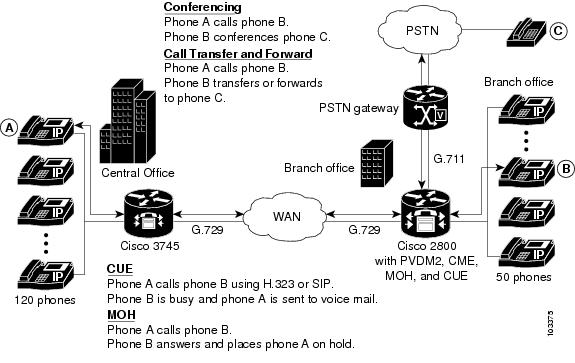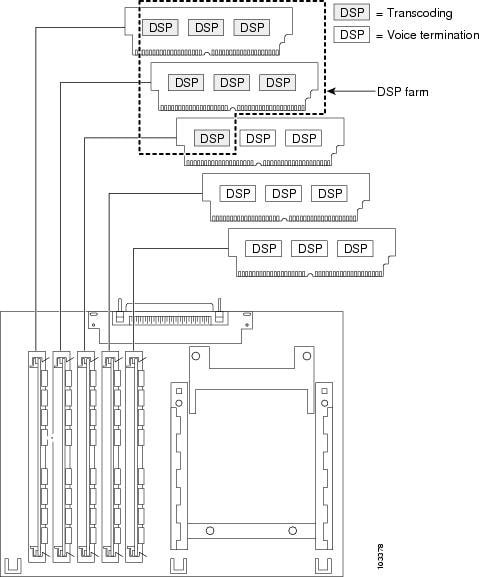|
Step 1
|
enable
|
Enables
privileged EXEC mode.
|
|
Step 2
|
configure terminal
Router# configure terminal
|
Enters global
configuration mode.
|
|
Step 3
|
voice-card
slot
Router(config)# voice-card 1
|
Enters
voice-card configuration mode for the network module on which you want to
enable DSP-farm services.
|
|
Step 4
|
dsp services dspfarm
Router(config-voicecard)# dsp services dspfarm
|
Enables
DSP-farm services for the voice card.
|
|
Step 5
|
exit
Router(config-voicecard)# exit
|
Exits
voice-card configuration mode.
|
|
Step 6
|
sccp local
interface-type interface-number
Router(config)# sccp local FastEthernet 0/0
|
Selects the
local interface that the SCCP applications (transcoding and conferencing)
should use to register with Cisco Unified CME.
-
interface-type —Interface type that the SCCP
application uses to register with Cisco Unified CME. The type can be an
interface address or a virtual-interface address such as Ethernet.
-
interface-number —Interface number that the SCCP
application uses to register with Cisco Unified CME.
|
|
Step 7
|
sccp ccm
ip-address
identifier
identifier-number
Router(config)# sccp ccm 10.10.10.1 identifier 1
|
Specifies the
Cisco Unified CME address.
-
ip-address —IP address of the Cisco Unified CME
router.
-
identifier
identifier-number —Number that identifies the
Cisco Unified CME router.
-
Repeat
this step to specify the address of a secondary Cisco Unified CME router.
|
|
Step 8
|
sccp
|
Enables SCCP
and its associated transcoding and conferencing applications.
|
|
Step 9
|
sccp ccm group
group-number
Router(config)# sccp ccm group 1
|
Creates a
Cisco Unified CME group and enters SCCP configuration mode for
Cisco Unified CME.
|
Note
|
A
Cisco Unified CME group is a naming device under which data for the DSP farms
is declared. Only one group is required.
|
|
|
Step 10
|
bind interface
interface-type interface-number
Router(config-sccp-ccm)# bind interface FastEthernet 0/0
|
(Optional)
Binds an interface to a Cisco Unified CME group so that the selected interface
is used for all calls that belong to the profiles that are associated to this
Cisco Unified CME group.
|
|
Step 11
|
associate ccm
identifier-number
priority
priority-number
Router(config-sccp-ccm)# associate ccm 1 priority 1
|
Associates a
Cisco Unified CME router with a group and establishes its priority within the
group.
-
identifier-number —Number that identifies the
Cisco Unified CME router. See the
sccp ccm
command in
Step 7.
-
priority —The priority of the Cisco Unified CME
router in the Cisco Unified CME group. Only one Cisco Unified CME group is
possible. Default: 1.
|
|
Step 12
|
associate profile
profile identifier
register device-name
Router(config-sccp-ccm)# associate profile 1 register mtp000a8eaca80
|
Associates a
DSP farm profile with a Cisco Unified CME group.
-
profile-identifier —Number that identifies the DSP
farm profile.
-
device-name —MAC address with the “mtp” prefix
added, where the MAC address is the burnt-in address of the physical interface
that is used to register as the SCCP device.
|
|
Step 13
|
keepalive retries
number
Router(config-sccp-ccm)# keepalive retries 5
|
Sets the
number of keepalive retries from SCCP to Cisco Unified CME.
|
|
Step 14
|
switchover method
[ graceful
|
immediate]
Router(config-sccp-ccm)# switchover method immediate
|
Sets the
switchover method that the SCCP client uses when its communication link to the
active Cisco Unified CME system goes down.
|
|
Step 15
|
switch back method
{ graceful
|
guard
timeout-guard-value
|
immediate
|
uptime
uptime-timeout-value}
Router(config-sccp-ccm)# switchback method immediate
|
Sets the
switch back method that the SCCP client uses when the primary or higher
priority Cisco Unified CME becomes available again.
-
graceful —Switchback happens only after all the
active sessions have been terminated gracefully.
-
guard
timeout-guard-value —Switchback happens either when
the active sessions have been terminated gracefully or when the guard timer
expires, whichever happens first. Timeout value is in seconds. Range:
60 to 172800. Default: 7200.
-
immediate —Switches back to the higher order
Cisco Unified CME immediately when the timer expires, whether there is an
active connection or not.
-
uptime
uptime-timeout-value —Initiates the uptime timer
when the higher-order Cisco Unified CME system comes alive. Timeout value is in
seconds. Range: 60 to 172800. Default: 7200.
|
|
Step 16
|
switchback interval
seconds
Router(config-sccp-ccm)# switchback interval 5
|
Sets the
amount of time that the DSP farm waits before polling the primary
Cisco Unified CME system when the current Cisco Unified CME switchback
connection fails.
|
|
Step 17
|
exit
Router(config-sccp-ccm)# exit
|
Exits SCCP
configuration mode.
|
|
Step 18
|
dspfarm profile
profile-identifier
transcode
[ security]
Router(config)# dspfarm profile 1 transcode security
|
Enters DSP
farm profile configuration mode and defines a profile for DSP farm services.
-
profile-identifier —Number that uniquely identifies
a profile. Range: 1 to 65535.
-
transcode —Enables profile for transcoding.
-
security —Enables secure DSP farm services. This
keyword is supported in Cisco Unified CME 4.2 and later versions.
|
|
Step 19
|
trustpoint
trustpoint-label
Router(config-dspfarm-profile)# trustpoint dspfarm
|
(Optional)
Associates a trustpoint with a DSP farm profile.
|
|
Step 20
|
codec
codec-type
Router(config-dspfarm-profile)# codec g711ulaw
|
Specifies
the codecs supported by a DSP farm profile.
|
|
Step 21
|
maximum sessions
number
Router(config-dspfarm-profile)# maximum sessions 5
|
Specifies
the maximum number of sessions that are supported by the profile.
|
|
Step 22
|
associate application
sccp
Router(config-dspfarm-profile)# associate application sccp
|
Associates
SCCP with the DSP farm profile.
|
|
Step 23
|
end
Router(config-dspfarm-profile)# end
|
Returns to
privileged EXEC mode.
|




 Feedback
Feedback